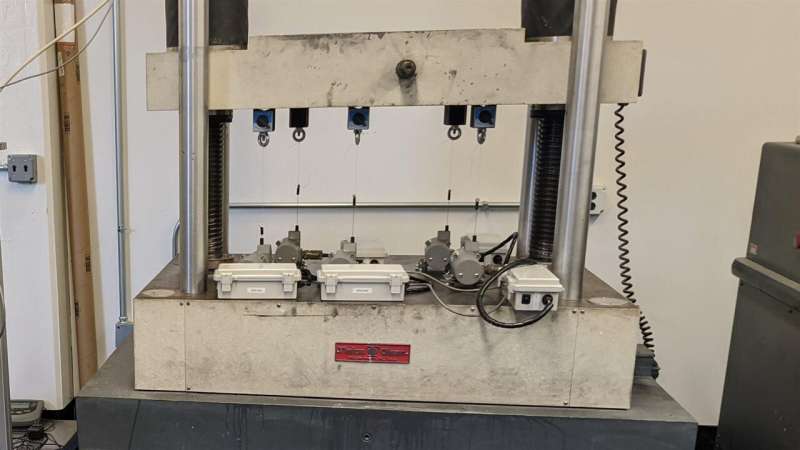This article has been reviewed according to Science X's editorial process and policies. Editors have highlighted the following attributes while ensuring the content's credibility:
fact-checked
trusted source
proofread
Researchers develop wireless sensor system for continuous monitoring of bridge deformation

Researchers in Drexel University's College of Engineering have developed a solar-powered, wireless sensor system that can continually monitor bridge deformation and could be used to alert authorities when the bridge performance deteriorates significantly. With more than 46,000 bridges across the country considered to be in poor condition, according to the American Society of Civil Engineers, a system like this could be both an important safety measure, as well as helping to triage repair and maintenance efforts.
The system, which measures bridge deformation and runs continuously on photovoltaic power, was unveiled in a recent edition of the IEEE Journal of Emerging and Selected Topics in Industrial Electronics in a paper authored by Drexel College of Engineering researchers, Ivan Bartoli, Ph.D., Mustafa Furkan, Ph.D., Fei Lu, Ph.D., and Yao Wang, a doctoral student in the College.
"With as much aging infrastructure as there is in the U.S. we need a way to keep a close eye on these critical assets 24/7," said Bartoli, who leads the Intelligent Infrastructure Alliance in the College of Engineering. "This is an urgent need, not just to prevent calamitous and often tragic failures, but to understand which bridges should take priority for maintenance and replacement, so that we can efficiently and sustainably approach the preservation and improvement of our infrastructure."
More than 40% of America's 617,000 bridges are more than 50 years old. While they are built to last, they must also be inspected regularly—every two years, according to Bartoli, who is a professor in the College's Department of Civil, Architectural and Environmental Engineering. The current practice is to make a visual inspection and, in rare cases, to monitor only the bridges deemed "problematic structures," he said.
But the number of bridges that require attention is growing, according to the ASCE's "Report Card for America's infrastructure." A system like Drexel's could help federal agencies and inspectors get their arms around the challenge and reduce the overall need for inspections as new bridges are built.
Their wireless displacement sensor consists of a solar photovoltaic cell, a deformation measuring device—called a displacement potentiometer—and a monitoring interface transceiver. All three are mounted on the bridge to take continuous measurements of its deformation as traffic moves across it and transmit that information to a remote monitoring station.
The displacement potentiometer is a small, robust, lightweight device that mounts to the girder of the bridge. It measures displacement, or movement of the girder, as the bridge temporarily deforms when vehicles pass along it. Changes in this pattern of deformation can be an early indicator of structural problems.
Because the system draws power from a solar cell and a backup battery, multiple potentiometers can be mounted on the bridge without wiring. The system can accommodate a number of different sensors that monitor bridge movements, such as acceleration, tilt and displacement, among other. Integrating multiple types of sensors into the system could provide a fuller picture of bridge health.
"The major advantage of this system is removing hundreds, and sometimes thousands, of feet of cables that are expensive, can be damaged, require care during installation and increase the overall cost of the sensing system," Bartoli said. "The other advantage is that with one wireless platform, we could simultaneously read many different types of sensors, not just displacements but also accelerometers, tiltmeters and strain gages."
A team of electrical engineers in Drexel's Department of Electrical and Computer Engineering designed the power supply for the system and optimized it for endurance and durability in all climates. It includes a 21.8 by 35-centimeter, 10-watt photovoltaic cell and a large-capacity 14.8-volt lithium-ion battery to store and disburse the energy it collects. They tested it in a lab and outside in the middle of winter in Pennsylvania, to ensure it could continue to provide power during the most challenging weather conditions.
"We want to ensure that the sensors can continually take measurements and transmit data throughout the entire day, so we used a large-capacity battery so that it can power the system overnight or if it is cloudy for long periods of time," said Wang, who led the development of the power system. "This configuration is expected to provide uninterrupted power for years and the battery can provide power on its own for three weeks if it's cloudy or the solar cell has been disabled."
The team hopes that proving an affordable, easy-to-install sensor array is rugged enough to withstand the elements with little or no maintenance for years will enable continuous monitoring of many bridges, not just those in poor condition. This level of data collection will help to determine what the "normal" structural behavior is for each bridge and raise an alert when that behavior unexpectedly changes.
"The goal is for the sensor to last indefinitely with minimal to no need for maintenance," Bartoli said. "Reliable, continuous monitoring ensures these structures are operating as intended. It allows us to capture data about overloads and the structural deformation caused by large loads on a bridge. It also allows us to see how the structure deforms due to environmental factors, such as wind and temperature changes, so we can ensure that all of these deformations are within the expected range.
While the system is currently ready for deployment, the team plans to continue testing and refining it in the lab by adding additional types of sensors and pushing to determine the full lifespan of the power supply.
More information: Yao Wang et al, Power Self-Sustained Wireless Bridge Deformation Monitoring System Based on Solar Photovoltaic, IEEE Journal of Emerging and Selected Topics in Industrial Electronics (2022). DOI: 10.1109/JESTIE.2022.3204487




















